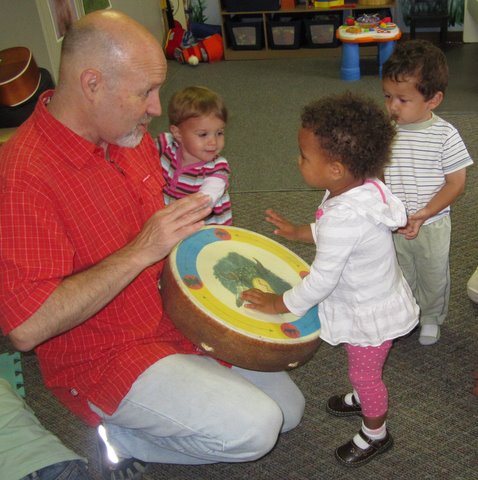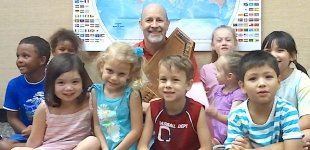
Teaching Artist Aaron Fowler with students
A few weeks ago, the Young Audiences Arts for Learning national office received a giant-sized thank you note from the McLean Science and Technology Magnet Elementary School in Wichita, Kansas. This poster, created by the school’s students, beautifully illustrated the Young Audiences Arts for Learning logo and thanked our Board Chairman, Corinne Greenberg; Board President, Bill Pearson; and Executive Director, David A. Dik. The poster was sent to thank us for supporting the highly successful Arts Partners STEM Learning through the Arts Research Project. Arts Partners is the Young Audiences Arts for Learning affiliate in Wichita, Kansas.
The Arts Partners program, STEM Learning through the Arts Research Project, is designed to measure teacher and student attitudes toward using arts strategies to learn STEM subjects and concepts at the elementary grade levels, PreK-5. The research consists of both control schools and treatment schools, where a series of STEAM residencies were implemented by local teaching artists. The acronym STEAM stands for science, technology, engineering, art, and math and it is a recent education initiative to help students develop 21st century learning skills. Young Audiences Arts for Learning believes that students who receive early access to STEAM programs will have a greater chance of success in higher education and their future careers.

This is the second year that Arts Partners received a prestigious Affiliate Development Fund Grant (ADF grant) from the Young Audiences national office to continue its STEM Learning through the Arts Research Project. Several of the residencies took place at McLean Science and Technology Magnet Elementary School where the Arts Partners teaching artists introduced a variety of arts disciplines to several classes. One of the artists, Aaron Fowler, led a STEAM-based residency program called The Science of Sound is All Around. This early education residency program creates connections between music concepts and scientific terminology that allows students to expand and deepen their understanding of both subjects. It is amazing to watch these young learners describe tone, timbre and pitch and also be able to demonstrate rhythm and harmony with their instruments.
One fourth grade teacher wrote in her evaluation, "As the students demonstrated their home‐made instruments, I could tell they understood the scientific concepts of decibels, frequency, hertz and timbre."
McLean Science and Technology Magnet Elementary is just one school in Wichita, Kansas, that participated in the STEM Learning through the Arts residency programs. Over half of Arts Partners’ overall programming had a STEM focus last year, and 44 of their programs were STEAM based! Arts Partners has been developing arts-integrated STEM programs since 2006, long before the STEAM acronym and education movement were established. One of their most successful residency programs is The Three-Legged Stool, a kinetic sculpture residency that integrates visual art and the creation of a closed circuit that powers a handheld electronic drawing device. Here is a video about the Three-Legged Stool Residency that was shown at the STEAM Caucus briefing in Washington, D.C., last year:
And congratulations to Katie Lynn, who retired in June as Arts Partners Executive Director and Lisa Muci, Arts Partners Program Director for their incredible work these past few years for creating and implementing this residency program.
About ADF Grants
The Young Audiences Arts for Learning’s national office is proud to have helped fund the STEM Learning through the Arts Research Project through the Affiliate Development Fund (ADF). The purpose of this fund is to encourage and support innovative strategies in all areas of organizational development for the betterment of the Network and the young people we serve. At the heart of the ADF grant program, now in its fifth year, is the expectation that the entire YA Network will benefit from the organizational development of each affiliate, which in turn will enable us to better carry out Young Audiences’ mission to inspire young people and expand their learning through the arts.
This article was contributed by Marcus Romero, Communications Manager, Young Audiences Arts for Learning


